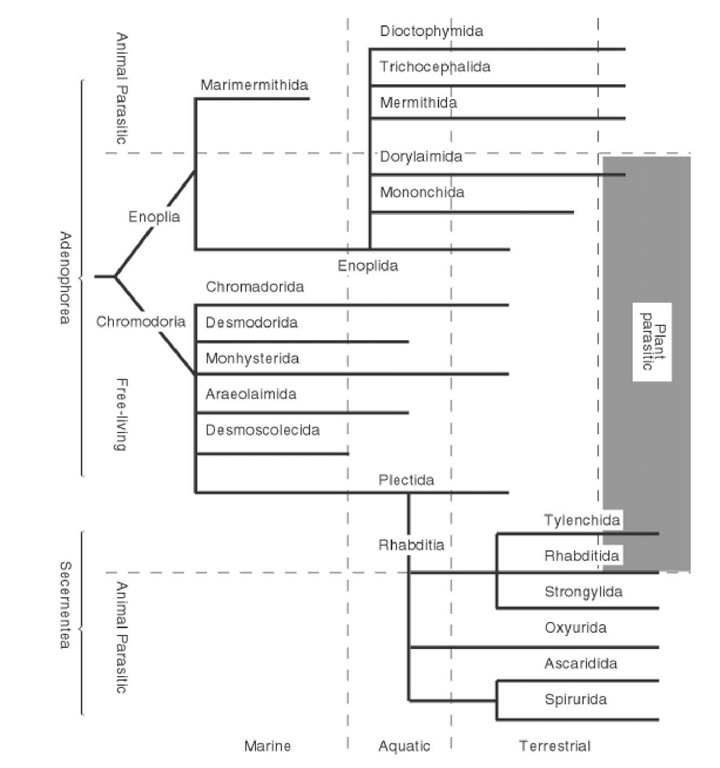Nematodes, commonly known as roundworms, are one of the most successful groups of animals on earth. It is estimated that they represent several percent of the total biomass, and that 80% of all living metazoans are nematodes (1). Their phylum, the Nematoda, includes free-living, plant-parasitic, and animal-parasitic species (see Ascaris). Adult nematodes range in length from less than 1 mm for some plant and free-living species to greater than 4 m for a whale intestinal parasite.
1. Lifestyles
Parasitic nematodes cause extensive economic loss and human suffering. Crop damage from the plant parasites in the United States alone is estimated at more than $5 billion annually. Livestock production is adversely affected by the animal parasites, which also are present in about 25% of the human population. Hookworm, pinworm, and filarial infections such as African river blindness and elephantiasis are common human diseases caused by parasitic nematodes, primarily in developing countries.
The majority of nematode species are free-living, found worldwide in soil as well as marine and aquatic environments, and generally harmless. One free-living soil species, Caenorhabditis elegans, has become one of the best understood "model organisms" for biological research, through extensive study of its genetics, anatomy, physiology, and development (see Caenorhabditis).
2. Anatomy and Physiology
In spite of their widely differing sizes and lifestyles, all nematodes are similar in their anatomy and physiology. All are simple animals with relatively few cells, and this phylum is one of only a very few that include species with fixed cell numbers and an invariant pattern of cell divisions during development. The basic nematode body plan can be simply described as a tube within a tube. The outer tube is an epidermal layer of cells (hypodermis), which secretes a tough, flexible collagenous cuticle covering the animal’s exterior. Associated with the inside of this tube are neurons and body-wall muscles. The inner tube is the digestive tract, including a muscular pharynx as well as the intestine, which runs from the posterior end of the pharynx to the anus. Between the two tubes is a space called the pseudocoelom, which is occupied by the gonad in adults. In free-living species, the pharynx is used to ingest and crush bacteria; in plant parasites it is specialized for boring into root tissue. Nematodes lack skeletal components and maintain their body shape by hydrostatic pressure.
3. Life Cycle and Development
Nematode embryos develop inside a chitinous egg shell, which forms shortly after fertilization. After hatching as first-stage juveniles, the worms grow through three more juvenile stages, separated by molts at which a new cuticle forms and the old one is shed. The fourth-stage juveniles molt to sexually mature adults, which continue growth to varying extents in different species. The four juvenile stages are commonly referred to as larval stages (L1-L4), although this nomenclature is not strictly correct because there is no metamorphosis to adulthood. In parasitic species, particular stages are often specialized for growth in a different host or host tissue. Free-living species are capable of molting under adverse conditions to an alternative form of the L3, called a dauer (enduring) larva, which is resistant to environmental stress, does not feed, and can survive for much longer than the normal lifespan. When conditions improve, the dauer larva can molt to the L4 and resume the normal life cycle (see Caenorhabditis ).
4. Evolution
The evolutionary relationship of nematodes to other animal phyla is still a subject of debate. It has been difficult to establish, partly because there is no nematode fossil record. Figure 1 shows the three possible evolutionary relationships between nematodes, arthropods (represented by Drosophila), and chordates (represented by the mouse). Based on present evidence, Figure 1a seems most likely and Figure 1c least likely; however, an argument has been made for Figure 1b based on molting as a common character of nematodes and arthropods (2).
Figure 1. The three possible evolutionary relationships between chordates, represented by the mouse, arthropods, represented by the fruit fly Drosophila, and nematodes. Vertical axis represents evolutionary time. See text for further explanation.
Within the phylum Nematoda, there are two major classes, termed Adenophorea and Secernentea. Figure 2 shows one possibility, based primarily on morphological characters, for the relationships of the various nematode orders, with their habitats and free-living or parasitic lifestyles indicated (3). A new classification based on ribosomal RNA sequences, currently in progress, suggests somewhat different relationships (M. Blaxter, personal communication).
Figure 2. Possible evolutionary relationships of nematode orders and their principal ecological niches. Multifurcations represent not simultaneous divergence events but rather uncertainty regarding sequences of divergence. Not indicated under "Marine" are several orders of the Secernentea that are parasites of marine vertebrates.


